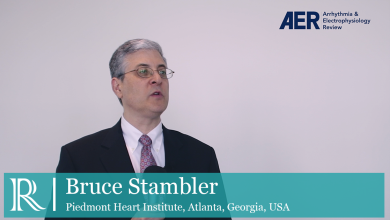Search results
Author(s):
Etienne Delacrétaz
Added:
3 years ago
Catheter ablation of SVT has emerged as a curative treatment with high success rates and plays a central role in the management of supraventricular tachycardia (SVT).This short review aims to give an update on the outcomes of catheter ablation and provide a guide to appropriate decision making in patients with SVT.
Mechanisms of SVT
Tachycardias can be categorized as ventricular (involving the…
View more
Author(s):
Loukas Pappas
,
Michalis Efremidis
,
Konstantinos P Letsas
,
et al
Added:
3 years ago
A 49-year-old man was admitted to the cardiology department because of an episode of palpitations, dizziness, and epigastric discomfort. He had no history of heart disease, but he reported episodes of regular palpitations during the past year. His standard 12-lead electrocardiogram (ECG) on admission was unremarkable. Physical examination and routine laboratory examinations, including blood and…
View more
Author(s):
Bruce S Stambler
Added:
6 years ago
Bruce Stambler from Piedmont Heart Institute, Atlanta, Georgia, USA discusses PSVT Node-1 Trial: Intranasal Etripamil For Conversion of Paroxysmal Supraventricular Tachycardia (PSVT) Node-1 Trial.
Filmed by Radcliffe Cardiology on-site at HRS 2017.
View more
Author(s):
Demosthenes G Katritsis
,
Giuseppe Boriani
,
Francisco G Cosio
,
et al
Added:
3 years ago
Endorsed by Heart Rhythm Society (HRS), Asia-Pacific Heart Rhythm Society (APHRS), and Sociedad Latinoamericana de Estimulación Cardiaca y Electrofisiologia (SOLAECE)
This is an executive summary of the full consensus document on the management of supraventricular tachycardia (SVT) patients published in Europace. The consensus document was prepared by a Task Force from the European Heart Rhythm…
View more
Author(s):
Jennifer N Avari
,
Edward K Rhee
Added:
3 years ago
Fetal tachyarrhythmias occur in approximately 0.4-0.6% of all fetuses.1-3 Normal fetal heart rates range from 120-160 beats per minute (bpm), with rates greater than 180bpm indicative of tachycardia.4-7 Usually, fetal arrhythmias are isolated findings; however, 5% of fetuses will also have congenital heart disease,8,9 such as Ebstein's anomaly, atrioventricular canal, hypoplastic left heart…
View more
Author(s):
Demosthenes G Katritsis
Added:
3 years ago
Supraventricular tachycardias (SVT) are common, with an estimated prevalence of 2.25/1,000 persons and an incidence of 35/100,000 person-years.1 Atrioventricular nodal reentrant tachycardia (AVNRT), in particular, represents the most common regular arrhythmia in the human, and its proportion increases with age.2 However, the European Society of Cardiology has not published management guidelines…
View more
Author(s):
Demosthenes G Katritsis
Added:
3 years ago
Although the exact circuit of atrioventricular nodal re-entrant tachycardia (AVNRT) still eludes us, AVNRT is the most common regular arrhythmia in humans, and therefore the most commonly encountered during ablation attempts for regular tachycardias.1–4 Catheter ablation for AVNRT is the current treatment of choice in symptomatic patients. It reduces arrhythmia-related hospitalisations and costs,…
View more
Sakis Themistoclakis
Research Area(s) / Expertise:
Author
Giulio Falasconi
Research Area(s) / Expertise:
Author
Luigi Pannone
Research Area(s) / Expertise:
Author












